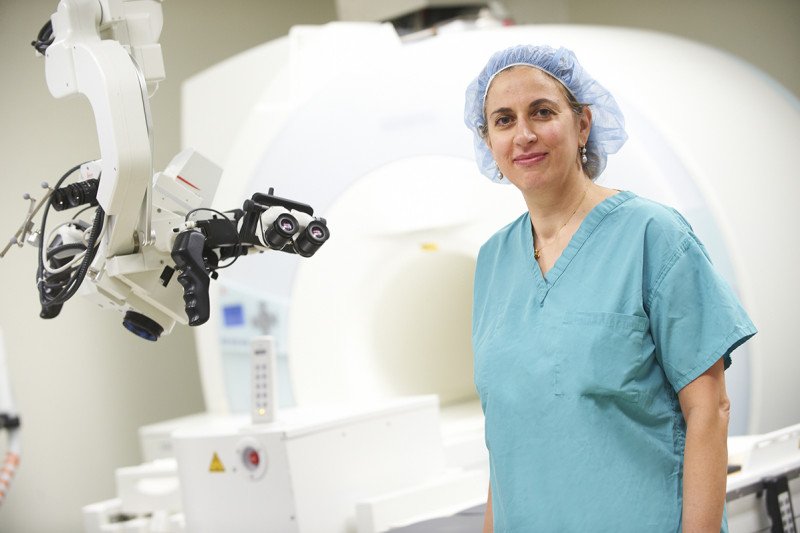
Editor’s Note: This story was originally published in July 2017.
Glioblastoma multiforme (GBM) is the most common primary brain cancer, responsible for 16% of brain malignancies. It can spread through brain tissue and can be difficult to remove entirely.
When Senator McCain’s office announced he had been diagnosed with the disease in July 2017, we spoke with Viviane Tabar, Chair of the Department of Neurosurgery and Theresa Feng Chair in Neurosurgical Oncology at Memorial Sloan Kettering.
What is glioblastoma?
Glioblastoma is a cancerous tumor of brain cells that rarely spreads outside the brain. This tumor is highly aggressive. Right now we don’t know of a direct cause, such as an environmental trigger. The majority of cases are not associated with a genetic predisposition.
What are the most common symptoms of glioblastoma?
Real estate is very important in the brain. If glioblastoma arises in the area of the brain that handles speech, it manifests very quickly as difficulty finding words, slurring, or even difficulty comprehending conversations. If it is present in the motor area, patients will notice weakness. However, there are large areas of the brain that contribute to more complex functions, like spatial orientation or multitasking. A tumor in one of these areas could initially give rise to more subtle symptoms, like minor difficulty orienting while walking or driving, or unusual fumbling with buttons while getting dressed. Some symptoms are often dismissed by patients as just being tired. Sometimes it takes a family member to notice changes in personality, like becoming more or less inhibited, growing quiet, or sleeping longer.
Meanwhile the tumor grows and can cause brain swelling, and because the brain is locked in a bone box, that swelling can cause more symptoms, like headaches.
What are the current treatment options?
The standard of care is to take out as much of the tumor as the patient can safely tolerate so that quality of life is impacted as little as possible. Our approach at MSK starts by performing surgery. We use state-of-the art technology, such as brain mapping techniques and MRI during surgery, to make sure all parts of a tumor are removed. Recovery usually takes about ten days, followed by radiation, often accompanied by chemotherapy.
Not all glioblastomas are the same. Sometimes they carry mutations that can be targeted with a specific drug. At MSK, after surgery the tumor tissue is sent for DNA sequencing by our MSK-IMPACT™ test. That can provide more information on the abnormalities within the tumor. We consider this sequencing to be crucial to the treatment plans for each individual person.
Tell us more about the strides made here at MSK in understanding the genetics of brain cancer cells. What does this mean for patients?
Precision medicine allows us to personalize each person’s treatment independently, using DNA sequencing. We know tumor DNA can give us valuable information. For instance, we know people with mutations in a gene called IDH1 will fare better than those who do not have mutations in that gene. In glioblastoma, arguably these kinds of advances have not been as great as with other cancers. But our goal is to find DNA changes that will help us decide which treatment is best suited for each person.
Are new therapies on the horizon? What clinical trials are under way?
Glioblastoma is the subject of significant research efforts. Researchers are trying to understand what makes it grow so aggressively and how to prevent the tumor cells from growing and resisting treatment. These ideas are then developed into clinical trials. New approaches are being developed in immunotherapy, vaccines, and new drugs. I believe that the future will bring better treatment for glioblastoma, but we are not there yet.
What should patients and their families know about how MSK treats glioblastoma and other brain cancers?
We approach this with a very hopeful outlook. There is a lot we can do to maximize well-being and to offer patients the most advanced care, from surgery to DNA sequencing and clinical trials. We also educate and support patients and their families.
Where a patient is treated makes a difference. For instance, having an experienced surgical team of doctors and nurses really matters when it comes to minimizing complications and improving outcomes. At MSK we also use a multidisciplinary approach to the diagnosis and treatment of brain tumors, meaning that we get input from a team of experts. I know the diagnosis is terrifying, but there is a lot we can do to improve a person’s quality of life.






